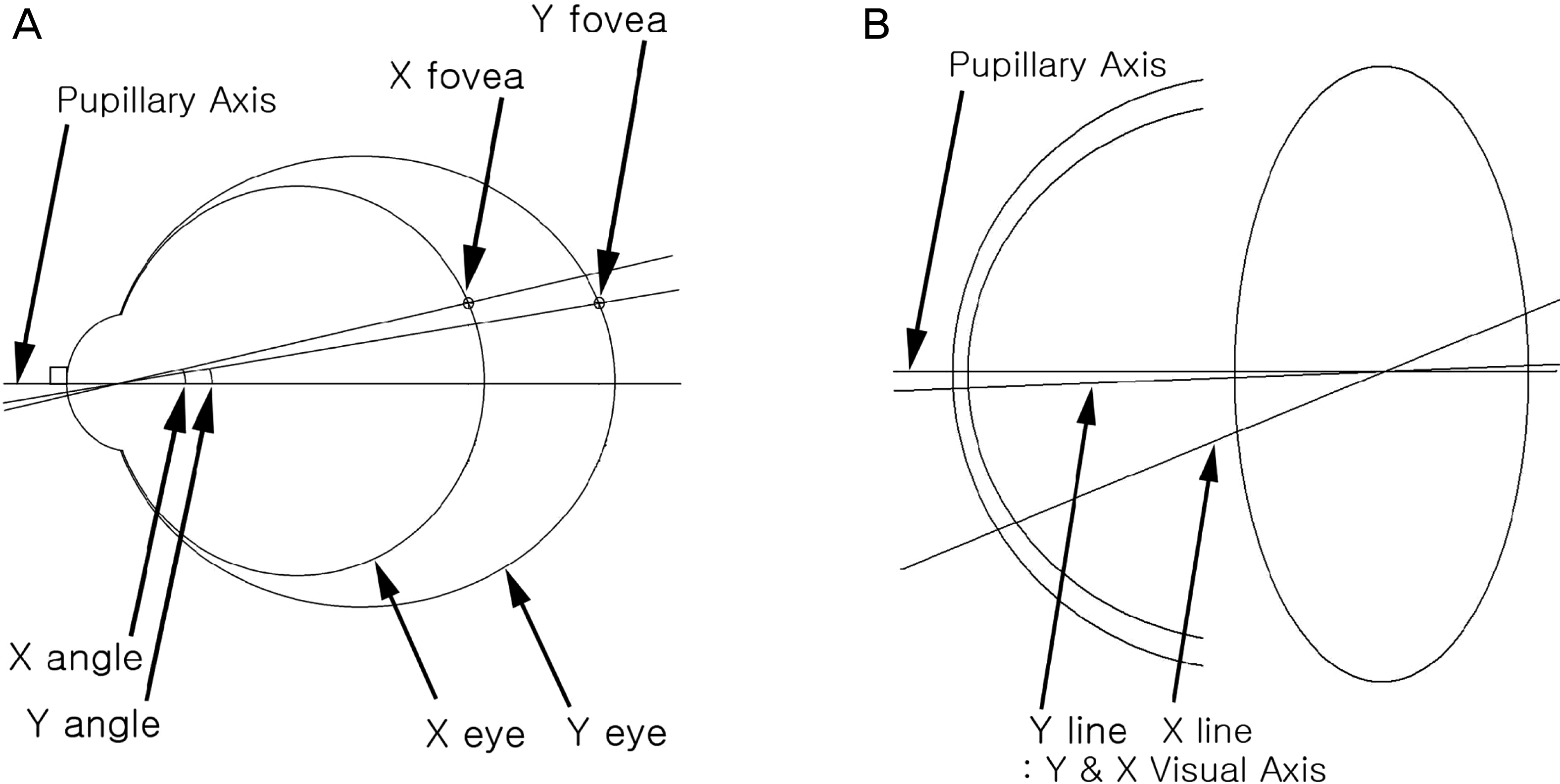초록
Purpose:
To evaluate differences between dominant and non-dominant eyes by analyzing angle kappa in dominant and non-dominant eyes.
Methods:
Fifty-seven subjects who had best corrected visual acuity 20/20 in the better-seeing eye and no underlying ocular disease were recruited. Ocular dominance was determined using the hole-in-the-card test. Corneal topography, refractive error, intraocular pressure (IOP), and axial length were evaluated in both eyes.
Results:
On corneal topography examination, the angle kappa and white-to-white measurements were significantly smaller in the dominant eye than the non-dominant eye ( p = 0.013 and p = 0.045, respectively). However, no significant differences in sim K’s’ astigmatism ( p = 0.210), central corneal thickness ( p = 0.533), and anterior chamber depth ( p = 0.216) were observed. In ad-dition, cylindrical powers of the subjects measured by autorefraction (AR) were significantly lower in the dominant eye ( p = 0.026); however no differences in spherical equivalent measured by AR ( p = 0.061), IOP measured using pneumonic tonometer ( p = 0.536), or axial length measured using laser biometry ( p = 0.093) were observed.
Go to : 
References
1. Ko CJ, Choi JS. A study on dominant eye. J Korean Ophthalmol Soc. 1983; 24:459–62.
2. Mapp AP, Ono H, Barbeito R. What does the dominant eye domi-nate? A brief and somewhat contentious review. Percept Psychophys. 2003; 65:310–7.

3. Cho KJ, Kim SY, Yang SW. The refractive errors of dominant and non-dominant eyes. J Korean Ophthalmol Soc. 2009; 50:275–9.

4. Cheng CY, Yen MY, Lin HY, et al. Association of ocular dominance and anisometropic myopia. Invest Ophthalmol Vis Sci. 2004; 45:2856–60.

5. Chia A, Jaurigue A, Gazzard G, et al. Ocular dominance, laterality, and refraction in Singaporean children. Invest Ophthalmol Vis Sci. 2007; 48:3533–6.

6. Samarawickrama C, Wang JJ, Huynh SC, et al. Macular thickness, retinal thickness, and optic disk parameters in dominant compared with nondominant eyes. J AAPOS. 2009; 13:142–7.

7. Dane S, Gümüştekin K, Yazici AT, Baykal O. Correlation between hand preference and intraocular pressure from right- and left-eyes in right- and left-handers. Vision Res. 2003; 43:405–8.

8. Linke SJ, Baviera J, Munzer G, et al. Association between ocular dominance and spherical/astigmatic anisometropia, age, and sex: analysis of 10,264 myopic individuals. Invest Ophthalmol Vis Sci. 2011; 52:9166–73.

9. Koran Association of Pediatric Ophthalmology and Strabismus. Current concepts in strabismus. 3rd ed. Korea: Naewae haksool;2013; chap. 9. 146–64.
Go to : 
 | Figure 1.Schematic diagram of the relationship between angle kappa and axial length. (A) In two eyes with a different axial length, eye with the longer axial length has a smaller angle kappa. In the figure, angle Y (of more myopic eye, Y eye) is smaller than angle X (of smaller eye, X eye). (B) X & Y line (X & Y visual axis) mean visual pathway of different eye (X eye is the smaller eye, and Y eye is the more myopic eye). Y line has a smaller angle kappa, and interferes less with the cornea and lens than the X line. |
Table 1.
Mean and mean difference* in white-to-white, angle kappa, axial length, spherical equivalent, and cylindrical power between ocular dominance and ocular non-dominance
| Measure | Dominant eye | Non-dominant eye | Mean difference* | p-value |
|---|---|---|---|---|
| White-to-white (mm) | 11.62 ± 0.35 | 11.70 ± 0.41 | -0.082 | 0.045† |
| Angle kappa (degree) | 3.91 ± 1.54 | 4.59 ± 2.27 | -0.683 | 0.013† |
| Axial length (mm) | 25.68 ± 1.25 | 25.61 ± 1.32 | 0.067 | 0.093 |
| SE (diopter) | -4.09 ± 3.11 | -3.91 ± 3.05 | -0.180 | 0.061 |
| Cylindrical power (diopter) | 0.87 ± 0.80 | 1.02 ± 0.79 | -0.149 | 0.026† |
Table 2.
Correlation analysis between white-to-white, angle kappa, axial length, spherical equivalent, and cylindrical power
| White-to-white | Angle kappa | Axial length | Spherical equivalent | Cylindrical power | ||
|---|---|---|---|---|---|---|
| Angle kappa | Correlation coefficient | 0.341 | - | - | - | - |
| p-value | 0.000* | - | - | - | - | |
| Axial length | Correlation coefficient | 0.157 | -0.307 | - | - | - |
| p-value | 0.095 | 0.001* | - | - | - | |
| Spherical equivalent | Correlation coefficient | 0.168 | 0.295 | -0.686 | - | - |
| p-value | 0.074 | 0.001* | 0.000* | - | - | |
| Cylindrical power | Correlation coefficient | 0.001 | -0.125 | 0.182 | -0.440 | - |
| p-value | 0.994 | 0.184 | 0.052 | 0.000* | - |




 PDF
PDF ePub
ePub Citation
Citation Print
Print


 XML Download
XML Download